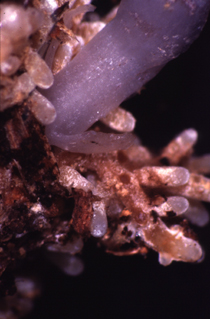Myco-heterotrophy facts for kids
Myco-heterotrophy is a special way some plants get their food. Instead of making their own food using sunlight (like most plants do through photosynthesis), these plants get all or some of their nutrition from fungi. It's a bit like a plant "borrowing" food from a fungus!
Contents
What is Myco-heterotrophy?
Most plants are green because they have chlorophyll. This green stuff helps them use sunlight, water, and air to make their own food. This process is called photosynthesis. But some plants are not green. They cannot do photosynthesis. These plants need another way to get food.
Myco-heterotrophic plants connect with fungi. The fungi usually get their food from dead plants or by helping other living plants. Myco-heterotrophic plants then take some of this food from the fungi. It is a type of parasitism, where one living thing benefits at the expense of another.
How Myco-heterotrophs Get Food
These plants do not have the parts needed for photosynthesis. They do not have green leaves. Instead, they have special roots. These roots connect with the underground parts of fungi, called mycelium. The mycelium is like a network of tiny threads.
The fungi collect nutrients from the soil or from other plants. Then, the myco-heterotrophic plant takes these nutrients from the fungus. It is a very clever way for plants to survive without sunlight.
Myco-heterotrophy vs. Saprophytes
For a long time, scientists thought these non-green plants were "saprophytes". Saprophytes are organisms that break down dead organic matter for food. Think of mushrooms growing on a dead log.
However, scientists later learned that plants cannot break down dead matter directly. No plant can do what fungi do. So, the idea that these plants were saprophytes was wrong. We now know they are myco-heterotrophs. They get their food by connecting to living fungi.
From Mycorrhiza to Myco-heterotrophy
Myco-heterotrophy is very similar to something called mycorrhiza. Mycorrhiza is a helpful relationship between plants and fungi. In mycorrhiza, both the plant and the fungus benefit. The plant gives the fungus some sugars it makes from photosynthesis. The fungus helps the plant get water and nutrients from the soil.
Scientists believe that myco-heterotrophy evolved from mycorrhiza. Over a very long time, some plants that had mycorrhizal relationships started to rely more and more on the fungus for food. Eventually, they stopped doing photosynthesis altogether. They became fully dependent on the fungi.
Examples of Myco-heterotrophic Plants
One famous example is the Monotropa uniflora, also known as the ghost plant or Indian pipe. This plant is white and waxy. It does not have any green parts. It gets all its food from fungi that are connected to trees. The ghost plant essentially "steals" nutrients that the fungus gets from the tree.
Other examples include some types of orchids. Many orchids start their lives as myco-heterotrophs. They rely on fungi to grow from seeds. Some orchids stay myco-heterotrophic their whole lives. Others develop green leaves later and start doing photosynthesis.
Why is This Important?
Studying myco-heterotrophy helps us understand how plants and fungi interact. It shows us how complex and diverse life on Earth can be. It also highlights how some plants have found unique ways to survive in different environments. These plants are a reminder that nature has many surprising strategies for life.
See also
 In Spanish: Micoheterotrofia para niños
In Spanish: Micoheterotrofia para niños



